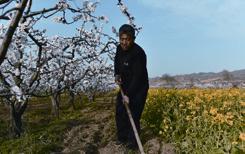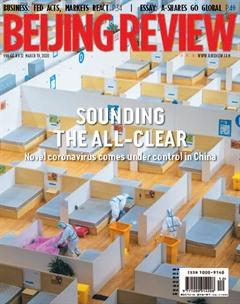FROM CHINA WITH LOVE

Medical experts sent by the Red Cross Society of China arrive in Iraqs Baghdad International Airport with anti-epidemic materials on March 7.
In the face of the challenges posed by the spread of the novel coronavirus disease 2019 (COVID-19) overseas, China is enhancing international cooperation on the prevention and control of COVID-19.

Resuming Construction
Work resumes at the construction site of the Beijing sub-administrative center station in Tongzhou District in Beijing on March 10.
Consumption Desire
Chinese people are ready to spend generously after the measures to control the novel coronavirus disease 2019 (COVID-19) are lifted, according to a survey conducted by the consumers council of Jiangsu Province in east China.
The survey collected answers from 21,192 respondents in the province from February 25 to March 1. It found that 89.6 percent of the respondents had suppressed the desire for dining out and shopping as well as going to movie theaters, gymnasiums and tourist spots.
In Chinas nationwide efforts to curb the epidemic, citizens have been encouraged to stay at home since the end of January to avoid infection, while stores and shopping malls have suspended operation or greatly reduced their hours. Cities also imposed various travel restrictions.
Restaurants, shopping malls, movie theaters, gymnasiums and tourist spots are the top fi ve destinations for consumers to unleash their spending after normal life resumes, and younger generations put dining out fi rst on their to-do list, according to the survey.
The suppressed consumption desire caused by the epidemic will also stimulate online shopping demand, as the survey found that 44.3 percent respondents would buy fresh food, new household appliances and fi tness equipment online.
Medical Waste
A recently released government document requires every prefecturelevel city to build at least one standardized medical waste disposal facility by the end of the year.
The document was released by authorities including the National Health Commission and the Ministry of Ecology and Environment (MEE).
Moreover, by the end of June 2022, every county should have built a complete system involving the collection, transportation and disposal of medical waste, Zhao Qunying, an MEE offi cial, said at a press conference on March 10.
The countrys medical waste disposal capacity has jumped 23 percent from 4,902 tons per day on average before the epidemic to 6,022 tons per day, Zhao said.
The medical waste disposal facilities are running at about 50 percent of their capacity on average, and medical waste is being disposed of in a timely manner, he said.
He added that of all medical waste, items related to the epidemic account for about 20 percent and can be disposed of on the day of generation.
Waste generated by healthcare activities includes a broad range of materials, from used needles and syringes to soiled dressings, body parts, diagnostic samples, blood, chemicals, pharmaceuticals, medical devices and radioactive materials, according to the World Health Organization.
There are still a few prefecturelevel cities that dont have medical waste disposal facilities and have to seek the help of neighboring cities.
Poverty Relief
The Central Governments poverty alleviation funds grew at an annual rate of 21 percent from 2013 to 2019, an offi cial said.
The government will continue to increase poverty alleviation funds in 2020 and has already allocated 113.6 billion yuan ($16.4 billion) to fi ght poverty this year, Huang Yan, an offi cial with the State Council Leading Group Offi ce of Poverty Alleviation and Development, said at a press conference on March 10.
Provincial-level regions, cities and counties have injected more than 200 billion yuan ($28.8 billion) into poverty alleviation this year, higher than the same period last year, she said.
Due to the epidemic, nearly half of migrant workers had not returned from their hometowns to their jobs in cities, Wei Baigang, an offi cial with the Ministry of Agriculture and Rural Affairs, said at the press conference.
Agricultural and rural affairs departments need to boost services to help them return to cities for work, he said.
For those engaged in farm work in villages, more should be done to help them prepare for spring farming and provide them with suffi cient agricultural materials and technological services, he said.
Online Hearings
Courts across China are doing their jobs via non-contact means amid the novel coronavirus outbreak, and about 59.3 percent of their cases were heard by video during the epidemic, according to the Supreme Peoples Court (SPC).
Courts have been conducting litigation online to reduce the fl ow and gathering of people to prevent the spread of the virus, an SPC offi cial said in a statement on March 10.
The SPC also published 10 typical cases involving crimes that harm prevention and control efforts on March 10.
They involve several types of crimes such as obstructing the prevention and treatment of the infectious disease, killing medical personnel, fabricating or intentionally spreading false epidemic information, and illegally hunting and killing wild animals.

Breathing in Fresh Air
Residents relax in a park in Lhasa, capital of Tibet Autonomous Region in southwest China, on March 10. Spring has arrived in Tibet with the weather getting warmer.
Going Green
Xiongan New Area in Hebei Province in north China plans to plant trees on 6,670 hectares this year.
The afforestation is to be implemented in spring and autumn, with the engineering cost for the spring session 708 million yuan ($102 million), according to China Xiongan Group.
By the end of 2019, Xiongan had planted 14 million trees covering 20,700 hectares, the governmentfunded company said.
In 2017, China announced the establishment of the new area to move non-capital functions out of Beijing.
Featuring hi-tech, smart urban planning and a sound ecological environment, the new area aims to become a signifi cant part of the Beijing-Tianjin-Hebei cluster and provide a Chinese solution to big city malaise, including overcrowding, pollution and traffi c congestion.
Control Relaxed
Hubei Province, the center of the novel coronavirus outbreak in central China, announced on March 10 it will adopt a differentiated personnel control policy, allowing healthy people from medium- and low-risk areas to travel within the province.
Via a mobile app, each resident will get a colored QR health code. A red code indicates the holder is a confi rmed or suspected COVID-19 patient, a yellow one indicates a close contact, while a green one means the holder poses no public health risk.
Green code holders from medium- and low-risk areas will be given a green light across the province to promote resumption of enterprises operation while ensuring the safety of personnel, according to a circular issued by the provincial COVID-19 control headquarters. Green code holders from high-risk areas must follow the travel rules of local authorities.
Yellow code holders will not be allowed to travel and those carrying red codes must be quarantined and treated.
A persons code color will change according to health condition.
The province has previously classifi ed its cities and counties based on the risks of the epidemic. Cities, counties and districts with no newly confi rmed cases in the last 14 days are categorized as lowrisk regions, those with fewer than 50 cases or those with over 50 but without a concentrated outbreak are classifi ed as medium-risk regions, and those with over 50 cases as well as a concentrated outbreak are classifi ed as high-risk regions.

Tender Care
A farmer in Yuncheng in Shanxi Province in north China removes weeds around apricot trees on March 10. Local farmers are using this time to tend to fruit trees.
Cloud Recruitment
Many colleges in Beijing are resorting to cloud recruitment for this years graduates instead of on-site recruiting sessions to avoid coronavirus transmission.
On the job information website of Peking University, 350 employers are offering more than 23,000 jobs. Students to graduate this summer can submit resumes and be interviewed online.
The universitys online recruiting session has drawn more than 2 million views, according to the universitys student career center. Peking University also provides free online training for students intending to interview for national civil service jobs.
For students of Renmin University of China, cloud recruitment allows them to submit resumes and have interviews online. Employers can hold campus talks with students on the Internet and interact with them there. The university has also established an online platform, offering guidance on career, recruitment and entrepreneurship.
Several other colleges in Beijing have similar measures to ensure smooth job hunting.
Alibaba Upgrade
Leading digital payment platform Alipay unveiled a three-year plan on March 10 to support the digital transformation of 40 million service providers by working with 5,000 independent software vendors.
“We want to build new infrastructure for a digitalized service industry by upgrading Alipay into a digital lifestyle platform,” Simon Hu, CEO of Alibabas fi nancial affi liate Ant Financial, said at the fi rst Alipay Partner Conference held on the same day.
Alipay has been upgraded to improve daily life services, with multiple sections for handy services including doorstep delivery and others related to greengrocers, supermarkets and pharmacies.
Alipay also announced that it has rolled out a supportive plan to help merchants undertake digital upgrades, as well as an incentive program that encourages developers of mini programs.
Launched in 2004, Alipay serves 900 million domestic users and provides e-government services in more than 400 cities.

Seeing Is Believing
A storekeeper livestreams to sell aquarium fi sh in a trading center in Anshan, Liaoning Province in northeast China, on March 10. The fi sh business suffered due to the outbreak of the epidemic but under the support of the local government, the center reopened on March 6 and switched to online marketing to reduce fi sh farmers losses.
Renewable Energy
Installed capacity of renewable energy in China grew 9 percent year on year to 794 million kilowatts by the end of last year, according to the National Energy Administration at a press conference on March 6.
Wind and solar farms saw capacity rise 14 percent and 17.3 percent respectively, while hydropower plants saw a 1.1-percent rise. Biomass power generation registered the fastest growth with capacity expanding 26.6 percent to 22.54 million kilowatts.
In 2019, 2.04 trillion kilowatthours of electricity was generated from renewable energy sources, which accounted for 27.9 percent of the total electricity output, up 1.2 percentage points year on year.
Renewable energy saw greater utilization effi ciency last year with wastage reduced. Hydropower utilization was 96 percent, up 4 percentage points, while average curtailment rates of wind and photovoltaic power dropped by 3 percentage points and 1 percentage point, respectively.
Land Market
Land sales in major Chinese cities saw a dramatic decline in February, an industry report showed on March 2.
The transaction volume in 40 cities monitored by E-House China R&D Institute in February tumbled year on year, while land price ticked up due to recovery of the market in fi rst-tier cities, the report said.
The land premium rate, which measures the extent the highestbidding property developers pay in excess of the starting land price, remained at a record low with limited possibility to fall further.
The market in second-tier cities signifi cantly cooled down in both transaction and volume, and third-tier cities also saw a gradual weakening trend.
After the outbreak ends, the pent-up demand will be unleashed with local policy support, Wang Yichen, a researcher at E-House China, said.
Wang said considering the low land premium rate currently, the market was unlikely to pick up in the short term. However, further decline of land price would be limited.
Structural Reform
China Unicom, one of the countrys top three telecom operators, has started a structural overhaul of its Internet-oriented operation and digital transformation.
According to a plan made public on March 6, the reform will address acute problems in lack of corporate coordination, product competitiveness and integration of online and offl ine businesses.
The operator will establish a four-tier operation system to better integrate its market resources.
It will also speed up the transformation of products, channels and innovation, and clarify management approaches and functions of the headquarters to boost organizational effi ciency.
A mixed-ownership revamp was launched in 2017 to introduce private investment.

The Way to Recovery
Trucks loaded with goods queue at the Friendship Pass in Nanning in Guangxi Zhuang Autonomous Region, south China, on March 4. Some ports between China and Viet Nam have resumed work and foreign trade has begun to recover.
Bankers Upbeat
Chinese bankers are optimistic about the steady growth of the economy despite the impact of the novel coronavirus disease, an industrial report showed on March 5.
They attach great importance to future technological innovation and progress as well as the development of smaller businesses, according to the 2019 Chinese Bankers Survey Report by the China Banking Association and global auditing and consulting fi rm PricewaterhouseCoopers.
The urban infrastructure industry remained the top receiver of credit investment for fi ve consecutive years by 2019, followed by information technology service and pharmaceuticals.
Micro and small enterprises ranked top on the list of banksfuture key clients, chosen by 84.1 percent of the bankers surveyed.
Lending to micro and small businesses and supply chain fi nancing led banks corporate fi nancial businesses, winning the support of 80.3 percent and 53.2 percent of the respondents, respectively.
Around 60 percent of the respondents predicted the nonperforming loan ratio would fall between 0.5 to 2 percentage points with gradual declines in three years. Most believed improvement in asset quality and development of fi nancial technology would enhance the steady growth of the industry.
The report has been released for 11 consecutive years, with the 2019 report based on the survey in 31 provincial-level administrative regions and Hong Kong Special Administrative Region.
New Route
A freight train loaded with chemical products departed on March 6 from Chongqing Municipality in southwest China for a port in the south, from where the goods will be shipped across the sea to foreign countries.
The new route starting from the logistics hub of Fuling in Chongqing is an expansion of the China-Singapore rail-sea transit route, which was launched in 2017 and has connected 220 ports in 92 countries and regions.
Thanks to the route, the cargo train carrying 50 standard containers of goods will arrive in Italy, Turkey and the Netherlands about 14 days faster than the traditional water route.
Since the novel coronavirus outbreak, Chongqing has introduced a spate of measures to reduce logistics costs for trade enterprises and ensure the normal operation of the rail-sea transit route.
By the end of February, over 1,600 freight trains had shipped more than 300 kinds of commodities worth $910 million on this route.

Turning the Economic Tide
Villagers relocated from impoverished areas work in a dam region in Rongjiang County, Guizhou Province in southwest China, on March 8. The county is ramping up the economy in dam areas by encouraging land transfer and company operations so that residents can work nearby and increase production and their income.

